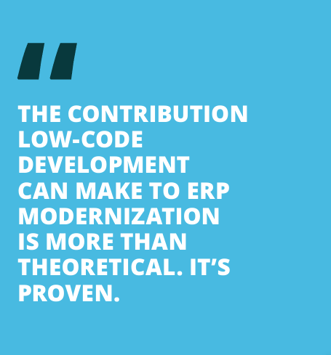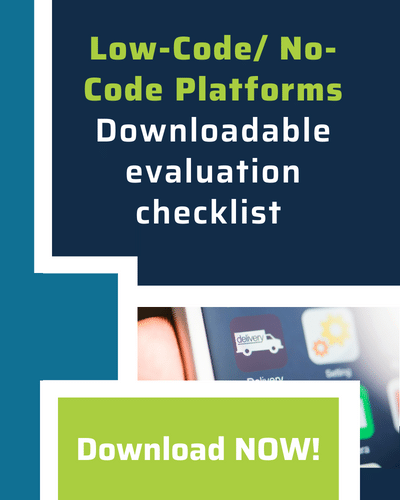Low-code and no-code development platforms are valuable tools for a variety of reasons. Their graphical, drag-and-drop workspaces minimize — or, in some cases, eliminate — coding, and they bring more people (regardless of training and experience) into the application development fold. Businesses and organizations can add up the ROI from using these platforms with time and cost savings, quicker time to market for mission-critical apps, increased operational efficiency, and greater competitiveness. It's clear that low-code platforms offer advantages, but arguably, the greatest advantage is for companies modernizing their enterprise resource planning (ERP) systems.
Challenges with ERP Modernization
It’s a simple truth: Technology advances. In response, ERP platforms evolve as new technology is available. An example that virtually all ERP users are familiar with is the shift from on-premises systems to the cloud. While the cloud promises greater agility, scalability, access to advanced technologies and opportunities for innovation, users do need to find a way to migrate there.
Businesses using an up-to-date ERP system with a clean core can make the transition relatively easily. But those businesses are rare. Although ERP systems offer long lists of features and capabilities, every operation is unique. Companies have found that they can increase productivity — and the bottom line — by deploying custom applications that streamline their specific, mission-critical processes. Long-time ERP users often have custom code that’s decades old and has been carried from on-premise systems update to update, but that would be difficult to move to the cloud. The developers that created the custom apps are long gone, moved on to other positions or retirement, and it’s harder and harder to find new developers wanting to work in proprietary language (e.g. SAP ABAP) to manage legacy applications written many years ago.
Therefore, businesses planning their transition to the cloud are looking for the best way to deal with custom code. SAPinsider’s Application Strategy and Development for SAP S/4HANA and Cloud research report states 18% of businesses are refactoring code for the cloud, 21% are retiring custom applications and settling for standard functionality, 28% are not moving custom code to the cloud, and 28% are still evaluating their options.
The Low-Code Solution
Low-code platforms created with ERP modernization in mind enable the transformation of legacy code and allow developers to upload legacy code to a workspace — much like importing information from a spreadsheet to a database. The platform can help developers identify legacy code that is necessary versus code that should be eliminated to minimize technical debt. These sophisticated low-code platforms then transform the legacy application to generate new applications on the low-code platform that developers can enhance with new capabilities.

It’s like jump-starting the development process for a new application using the legacy application and, at the same time, eliminating technical debt of legacy applications. Furthermore, the platform provides agility when technology advances in the future. So, practically, enterprises could modernize legacy custom code now and continue to use it with their current ERP system. Then, they can use the low-code platform to prepare for an easier move to the cloud — or other potential transformation — later.
The Impact Low-Code Solutions Are Making on ERP Modernization
The contribution low-code development can make to ERP modernization is more than theoretical. It’s proven. One success story is Dole Packaged Foods. The company leveraged low-code development to create mobile applications for its operations and saved 30% on costs, simplifying the upgrade from SAP ECC 6.0 to SAP S/4HANA along the way.
A global oil and gas drilling contractor also chose low-code development to modernize, digitize, and mobilize dozens of applications — especially in no-connectivity scenarios, something common in oil and gas operations. Moreover, the company reduced development time from months to weeks, with significantly fewer resources.
Look to Brown-Forman as well, who chose low-code development to upgrade manual processes and create future-proof apps that can adapt to new systems or devices their team might in the future, while making their ERP’s core clean.
The Competition Isn’t Waiting
Each day that a business waits to modernize its ERP environment is a day’s head start they’re giving to their competition. An updated IT ecosystem with ERP at its core gives users almost limitless capabilities to connect and automate processes, collect data for smarter business decisions and better customer service, and to control costs and increase profitability. When enterprises find the solution to the problem of legacy code during cloud migration, they should act as quickly as possible to maintain their competitive position.
Originally published by ERPNews Issue #27
Full article copy can be downloaded here



 Back
Back/Logo%20-%20black%20text%20blue%20pillar%20(large)-1.jpg)

